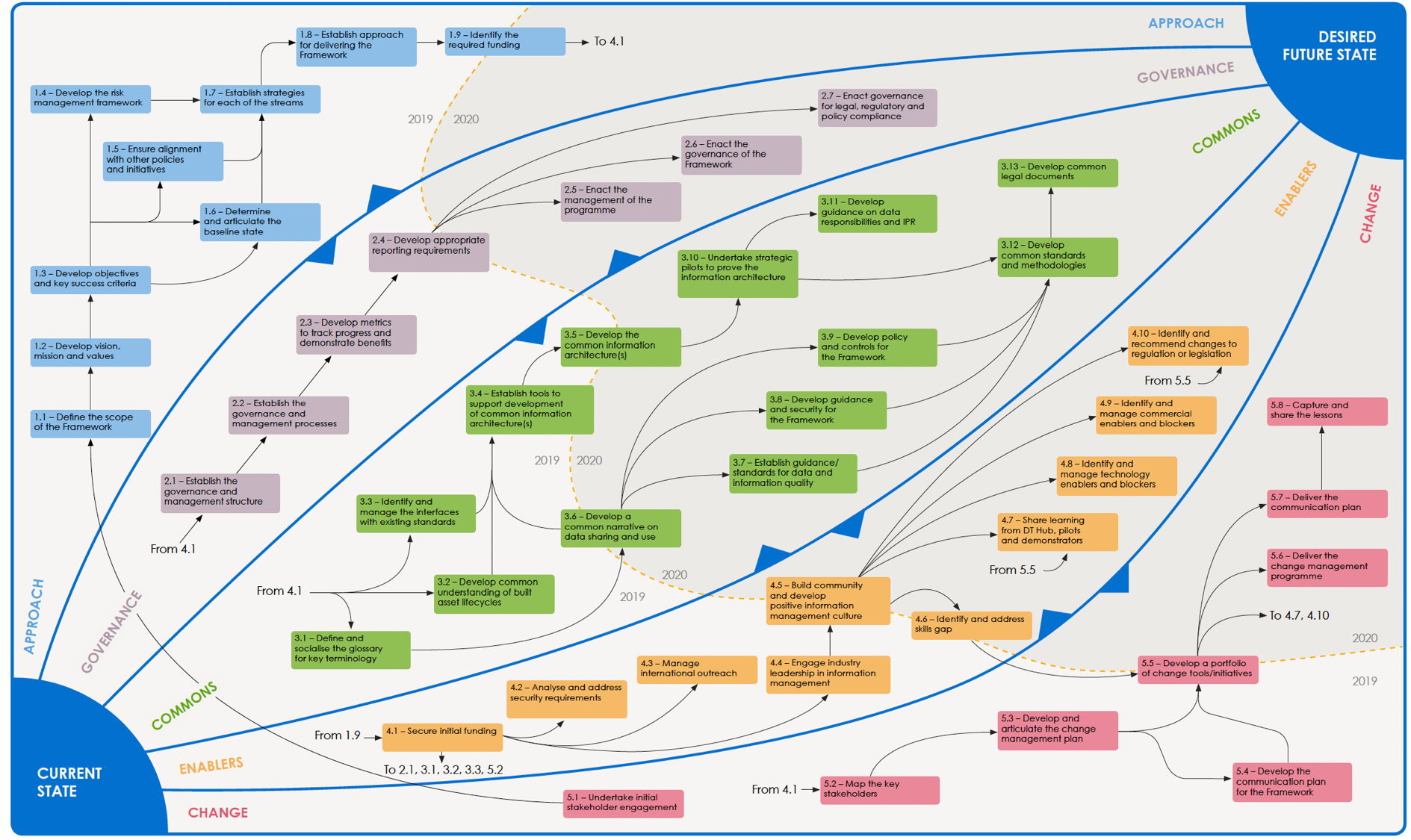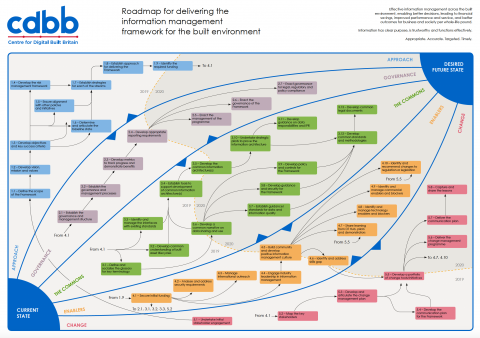
Submitted by Angela Walters on Fri, 05/04/2019 - 18:59
The Centre for Digital Built Britain (CDBB) is delighted to publish the Roadmap - the next output of the Digital Framework Task Group (DFTG). The Roadmap sets out how the Information Management Framework for the built environment (the ‘Framework’) will be delivered, which in turn will enable the development of the National Digital Twin (NDT).
A digitally enabled built environment will transform the way we live, play and work. Buildings and infrastructure will be ‘better’ – not just cheaper and more efficient, but smarter. The data they produce will be used to inform better decision throughout their lifecycles, beyond design and build, into operation, maintenance and use. And this will not just be for individual assets, but also for networks and entire systems – the whole built environment. The goal is effective information management that enables secure, resilient data sharing and that puts the right insight in the right hands at the right time to make the right decisions. All this will underpin the NDT – an ecosystem of digital twins, connected via securely shared data. The NDT has the potential to multiply the savings and efficiencies by facilitating interconnections between organisations and across sectors.
The National Infrastructure Commission’s 2017 report ‘Data for the public good’ highlighted the need for a strong national programme and leadership to create standards and a national focus for the best possible use of data in the built environment. The Government’s response was to ask CDBB to lead the development of the Information Management Framework and create the DFTG chaired by Mark Enzer, Chief Technical Officer of Mott MacDonald, to lead the national approach to the next generation of digital applications. The Gemini Principles, providing the ‘conscience’ of the Framework was published late in 2018, and the feedback from this has fed into the development of the Roadmap.
|
Click on the roadmap image below and download the interactive pdf (the interactive features work best in Adobe). NOTE: The interactive viewing works best in Adobe. As an alternative for mobile devices or online viewing please click here, but please note that some features may not work. |
The Roadmap is split into five connected streams. The ‘Approach’ stream considers and defines the overall strategy for delivering the benefits of effective information management across the built environment. To establish the structures and processes for managing the development, adoption and ongoing oversight of the Framework, there is a ‘Governance’ stream. The ‘Commons’ stream develops the necessary support for effective information management via guidance, tools and standards. An ‘Enablers’ stream seeks to identify and address the key potential blockers. Finally, a considerable ‘Change’ stream is needed to facilitate the adoption of the Framework across the whole ecosystem of the built environment.
The UK has led the way in the use of digital tools in construction and we now seek to forge ahead, creating a digitally connected built environment which is more responsive to people’s needs. At the heart of CDBB's programme is the drive to enable the NDT, where the digital models sit alongside actual schools, hospitals, road and rail networks to help planning and to better inform decisions – predicting and solving issues before they become problems. Greater data sharing could release an additional £7bn per year of benefits across the UK infrastructure sectors, equivalent to 25% of total spend.
The Industrial Strategy sets out a clear vision on how the UK will use data and digital technology to lead the fourth industrial revolution – investing in science and research to keep the UK at the forefront of new technologies, nurturing the talent of tomorrow, and transforming the places where we live and work; and how this will provide benefits to society and the economy. Digital technologies and data have the potential to generate considerable savings in the design, build, and operation of our built assets and infrastructure.
The next stage for CDBB is to launch the Digital Twin Hub (DT Hub), a collaborative, learning community for those who own or develop Digital Twins. CDBB and the DFTG are pleased to announce that Samuel Chorlton of the Data and Analytics Facility for National Infrastructure (DAFNI) will Chair the Steering Group that will establish the DT Hub.
CDBB and the DFTG would like to invite industry leaders to act as champions for the organisational, societal and economic benefits possible through effective information management. Those involved in planning, creating and managing the built environment are invited to provide feedback on the Roadmap by contacting enquiries@cdbb.cam.ac.uk. To stay up to date with DT Hub development, please visit www.cdbb.cam.ac.uk and sign up to receive the CDBB newsletter.
Announcing the launch of the Roadmap and DT Hub Steering group, Robin Webb, Deputy Director, Infrastructure and Procurement, Department for Business, Energy and Industrial Strategy said:
“The Digital Framework Task Group has done an impressive job in a short time in laying out the path to a National Digital Twin for infrastructure, and to realising the benefits for society of a smarter built environment. The publication of the Roadmap is an important and exciting further milestone on the journey, and I congratulate Mark Enzer and the Group, and CDBB on it.”
Publishing the Roadmap, Chair of the DFTG and Roadmap Working Group, Mark Enzer said:
“The Gemini Principles provided the conscience of this Information Management Framework and today’s publication takes us one step further – providing a map of the first years of the journey that will lead to delivery of the Framework for the built environment. I would like to take this opportunity to thank all of those involved, especially the members of the Roadmap Working Group – their time and expertise has been absolutely invaluable.”
Launching the establishment of the DT Hub Steering Group, Chair Samuel Chorlton from DAFNI said:
“I am delighted to be leading the Digital Twin Hub Steering Group. The DT Hub will be a collaborative web-enabled community for those who own, or who are developing, digital twins within the built environment, and is intended to ensure that knowledge and experience is shared to maximise learnings. The DT Hub will involve the wider digital twin community in developing a framework that works for everybody.”
Professor Andy Neely, Pro-Vice Chancellor at the University of Cambridge and Director of CDBB said:
“The publication of the Roadmap and the establishment of the Steering Group to develop the Digital Twin Hub provides a landmark in the development of the Information Management Framework for the built environment, and we are grateful for support from the Department for Business, Energy and Industrial Strategy. CDBB is excited to be asked by government to be the focal point and leader of this digital transformation and ensuring that the benefits that will be gained are targeted towards a benefit to society.”
More details:
DFTG Roadmap Webpage
DFTG Digital Twin Hub Web Page
DFTG Gemini Principles Web Page
About the Digital Framework Task Group (DFTG)
The Centre for Digital Built Britain’s Digital Framework Task Group (DFTG) was launched by HM Treasury in July 2018 following recommendations by the National Infrastructure Commission in the report Data for the Public Good. The report recommended:
- A National Digital Twin – enabling digital twins to come together to help plan, predict and understand our assets;
- A Digital Framework – for effective information management; secure sharing of data;
- A Digital Framework Task Group – set up by the Centre for Digital Built Britain to provide coordination.
The overarching purpose of the DFTG is to steer and guide the successful development and adoption of the Information Management Framework for the built environment. The creation of the framework forms an integral part of HM Government’s modern Industrial Strategy and Construction Sector Deal. The framework will establish the building blocks to enable effective information management across the built environment and will pave the way for the development of the national digital twin. The DFTG is made up of senior leaders within the landscape and is chaired by Mark Enzer, Chief Technical Officer of Mott MacDonald.
The Roadmap sets out how the Information Management Framework for the built environment (the ‘Framework’) will be delivered and in turn enable the development of the National Digital Twin (NDT). In particular, the Roadmap shows how the key building blocks of the Framework will fit together to enable effective information management across the built environment. The Roadmap details the work required across five workstreams – Approach, Governance, Commons, Enablers and Change. The Framework will provide effective information management across the built environment, enabling better decisions, leading to financial savings, improved performance and service and better outcomes for business and society per whole-life pound. Essentially - the right information in the right hands at the right time.
The Roadmap was developed by the Roadmap Working Group, chaired by Mark Enzer, Chief Technical Officer of Mott MacDonald and with a membership comprised of academics, government and industry partners.
The interactive PDF is available at: www.cdbb.cam.ac.uk/DFTG
CDBB is establishing the Digital Twin Hub (DT Hub), a collaborative web-enabled community for those who own, or who are developing, digital twins within the built environment. The DT Hub will give members a safe space where they can learn from, and share with, others who are on the same journey. Members will be able to participate in events that will not only develop their own capabilities, but also advance the state of the art in digital twins. The DT Hub Steering Group will be chaired by Samuel Chorlton of the Data and Analytics Facility for National Infrastructure (DAFNI).
The key objectives of the DT Hub are:
- To provide a focus for learning and sharing experiences on digital twins
- To drive innovation, develop expertise and advance the “state of the art” for digital twins in the built environment
- To identify good practice, develop guidance and (potentially) produce standards on data sharing and digital twins
- To showcase the benefits of digital twins; creating use cases and case studies that will provide evidence for developing business cases
- To create a support network for seeking partners and finding support in addressing challenges
- To provide a register of work on digital twins within the built environment; showing who is doing what where; identifying the leading digital twins, pilots and demonstrators
- To identify gaps that need to be addressed in moving towards a National Digital Twin and to define the additional work/pilots that will address them
- To promote the adoption of the Information Management Framework and to create the basis of the National Digital Twin
Definitions
The Information Management Framework – The Framework aims to establish all of the building blocks that are necessary to enable effective information management across the built environment throughout its lifecycle. The Framework enables secure, resilient interoperability of data, which is at the heart of the National Digital Twin.
Digital Twin – Within the scope of digital built Britain, a Digital Twin is: “a realistic digital representation of assets, processes or systems in the built or natural environment”. A Digital Twin unlocks value by supporting better decisions that lead to better outcomes in the physical world. Digital Twins have a key part to play in the digital transformation of the built environment.
National Digital Twin – The National Digital Twin is not a huge singular model of the entire built environment. Rather, it is “an ecosystem of Digital Twins that are joined together via the secure, resilient interoperability of data”.

